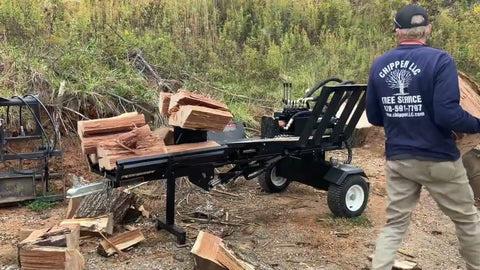Log splitters are powerful tools that simplify the tedious task of breaking down logs. “How to start a log splitter” might seem like a basic question, but ensuring a proper startup is essential for both efficiency and safety. This article delves deep into starting various types of log splitters while emphasizing precautions to take for a seamless wood splitting experience.
Types of Log Splitters
Log splitters are a game-changer for anyone dealing with large quantities of wood. Depending on their mechanisms and power sources, log splitters can be classified into several types. The most common are the hydraulic and kinetic (flywheel) log splitters. However, when we discuss their power sources, these splitters can further be divided into electric and gas-powered. Each type has its distinct features and starting methods.
Hydraulic log splitters utilize the principles of hydraulic fluid mechanics to generate immense force. This force drives the splitting wedge into the wood. Depending on the power source, hydraulic log splitters can be electric or gas-powered. They are popular due to their consistent splitting power and efficiency.
Kinetic (flywheel) log splitters, on the other hand, harness the power stored in rapidly spinning flywheels. When engaged, the stored energy in these flywheels is released in a quick burst to drive the splitting wedge, making the splitting cycle faster than most hydraulic models.
Table: Starting Methods for Different Types of Log Splitters
Type of Log Splitter Starting Method Hydraulic – Electric Powered Connect to an electrical outlet, ensure hydraulic fluid is at the correct level, and turn on the engine switch. Hydraulic – Gas Powered Check fuel levels, open the fuel tap, adjust the choke and throttle, then pull the starter cord until the engine fires. Kinetic (Flywheel) Ensure the flywheel is free from obstructions, engage the system to start spinning the flywheel, then wait for it to reach optimal speed.
When choosing a log splitter, consider the volume of wood you’ll be handling, the frequency of use, and your power source availability. The right choice will make your wood-splitting tasks much more manageable.
Safety Precautions Before Starting
Safety should never be compromised when working with machinery, especially with log splitters that exert significant force. Before diving into log splitting, there are several safety precautions to keep in mind:
-
Safety Gear: Equip yourself with appropriate safety gear. This not only protects you from potential harm but also enhances your efficiency. Sturdy shoes ensure you have a good grip and stability. Gloves protect your hands from splinters and provide a better grip on logs. Safety glasses are vital to shield your eyes from flying wood debris and splinters.
-
Workspace Preparation: It’s essential to maintain a clean and uncluttered workspace. An organized space reduces the chances of accidents like tripping over logs or tools. Ensure that the ground is even and that there are no obstructions around where you’ll be moving.
-
Machine Placement: Your wood splitter should be sitting flat on stable ground. If it wobbles or isn’t secure, there’s a risk of it tipping over during operation, leading to potential injury or damage.
-
Safety Stickers: Always ensure that safety stickers on the machine are not only visible but also legible. These stickers usually contain vital operational and safety information. If they’re faded or peeling off, consider getting replacements.
-
Obstructions: Before starting, check the machine for any obstructions or debris. A stray piece of wood or a tool can disrupt the machine’s function or become a projectile.
-
One Person Operation: Most log splitters are designed for a one person operation. Having too many people around can lead to confusion or miscommunication, increasing the risk of accidents. It’s best to operate the machine solo and ensure others maintain a safe distance.
General Startup Procedure

Starting a log splitter isn’t just about turning it on; it’s about ensuring optimal safety and efficiency. Before diving into the specifics of each type, let’s discuss some overarching practices:
Initial Checks for All Log Splitters:
-
-
Hydraulic Fluid Levels (Hydraulic Models): These machines rely on hydraulic fluid to generate the force needed for splitting. Ensure the hydraulic fluid reservoir is filled to the manufacturer’s recommended level, and there are no visible leaks.
-
Inspect the Splitting Wedge: A dull or misaligned wedge can result in inefficient splitting, causing strain on the machine and potentially damaging the wood. Regularly inspect the wedge for sharpness and alignment.
-
Log Cradle Security: This is where you’ll place your logs. Ensure that it’s securely attached, stable, and free from damage or excessive wear.
Starting an Electric Log Splitter:
-
Power Connection: Ensure the machine is connected to an appropriate power source, typically a grounded outlet. Avoid using extension cords unless they are of the correct gauge and specifically designed for heavy-duty machinery.
-
Engine Activation: Turn on the engine switch. If you feel a slight resistance, it usually indicates a sound electrical connection.
-
Warm-Up Period: Some models benefit from a short warm-up period. This allows the motor to reach its optimal operating conditions, ensuring efficient and consistent performance.
Starting a Gas-Powered Log Splitter:
-
Fuel Check: Gas-powered log splitters rely on fuel. Ensure your tank is adequately filled, and always have some extra on hand.
-
Fuel Valve: Before starting, open the fuel tap to allow gas flow.
-
Choke and Throttle Adjustment: These adjustments help in the initial start-up of the engine. Set the choke to the starting position and adjust the throttle as recommended by the manufacturer.
-
Starter Cord Engagement: Firmly and swiftly pull the starter cord. It may take a few sharp pulls. If the engine doesn’t start, the starter cord recoil mechanism ensures the cord safely returns, preventing any potential harm.
-
Choke Readjustment: Once the engine fires up and begins to warm, gradually adjust the choke to its regular operating position.
Starting a Kinetic Log Splitter:
-
Flywheel Inspection: Ensure the flywheel area is free from any debris or obstructions. Foreign objects can damage the flywheel or reduce its efficiency.
-
Engagement of Control Levers: These levers initiate the spinning of the flywheel. Engage them and ensure they’re functioning correctly.
-
Optimal Speed Wait: Once engaged, wait for the flywheel to attain its optimal speed. When it’s at this speed, it’s harnessed enough energy to split wood effectively.
-
Each log splitter, irrespective of its type, requires careful attention during the start-up process. Following these procedures will ensure not just efficient operation but also prolong the machine’s lifespan. Always refer to the manufacturer’s guidelines and ensure routine maintenance for optimal performance.
Operational Tips
-
Positioning logs correctly ensures clean wood splits.
-
Periodically check the splitting wedge for sharpness. A dull blade will struggle even with soft woods.
-
Adhere to the recommended maintenance schedules for longevity.
Troubleshooting Common Issues with Log Splitters

Operating machinery like log splitters can sometimes pose challenges, especially when things don’t go as expected. Understanding potential problems and knowing how to address them can significantly reduce downtime and frustration. Below are some common issues you might face with log splitters and suggested troubleshooting steps:
-
Engine Doesn’t Start:
-
This problem is more frequent in gas-powered log splitters.
-
Check for any loose or disconnected wires, especially in electric splitters.
-
For gas-powered splitters, ensure there’s sufficient fuel. If the fuel is old, consider replacing it with fresh fuel.
-
The spark plug might be faulty or dirty; consider cleaning or replacing it.
-
-
Loss in Hydraulic Pressure:
-
This is a prevalent issue in hydraulic log splitters.
-
A significant loss in pressure can cause inefficient splitting.
-
Regularly inspect the hydraulic fluid level and top it up if necessary.
-
Check for leaks in hoses or fittings and fix or replace them as required.
-
-
Flywheel Doesn’t Spin (Kinetic Log Splitters):
-
The flywheel’s purpose is to store and release energy quickly.
-
If it’s not spinning, it could be due to obstructions or issues with the control levers.
-
Ensure there’s no debris or any other obstructions hindering its movement.
-
Check the control levers to ensure they’re functioning and engaged correctly.
-
Table: Troubleshooting Common Issues with Log Splitters
Issue Potential Causes Suggested Solutions Engine Doesn’t Start
– Loose connections
– Low or old fuel
– Faulty spark plug
– Secure connections
– Refill or replace fuel
– Clean or replace spark plug
Loss in Hydraulic Pressure
– Low hydraulic fluid levels
– Leaks in system
– Top up hydraulic fluid
– Inspect & fix leaks
Flywheel Doesn’t Spin (Kinetic Models)
– Obstructions
– Malfunctioning control levers
– Clear obstructions
– Check & adjust levers
It’s worth noting that while these solutions address many common issues, sometimes the problem might be more complex, requiring professional intervention. Always consult your log splitter’s manual for guidance and consider reaching out to the manufacturer or a professional if unsure.
Conclusion
Knowing how to use a log splitter, particularly a gas-powered log splitter, is crucial for anyone aiming to split logs efficiently. Regular checks, proper safety measures, and understanding your machine’s nuances will ensure that every split log is a testament to your mastery over the art of splitting wood.

